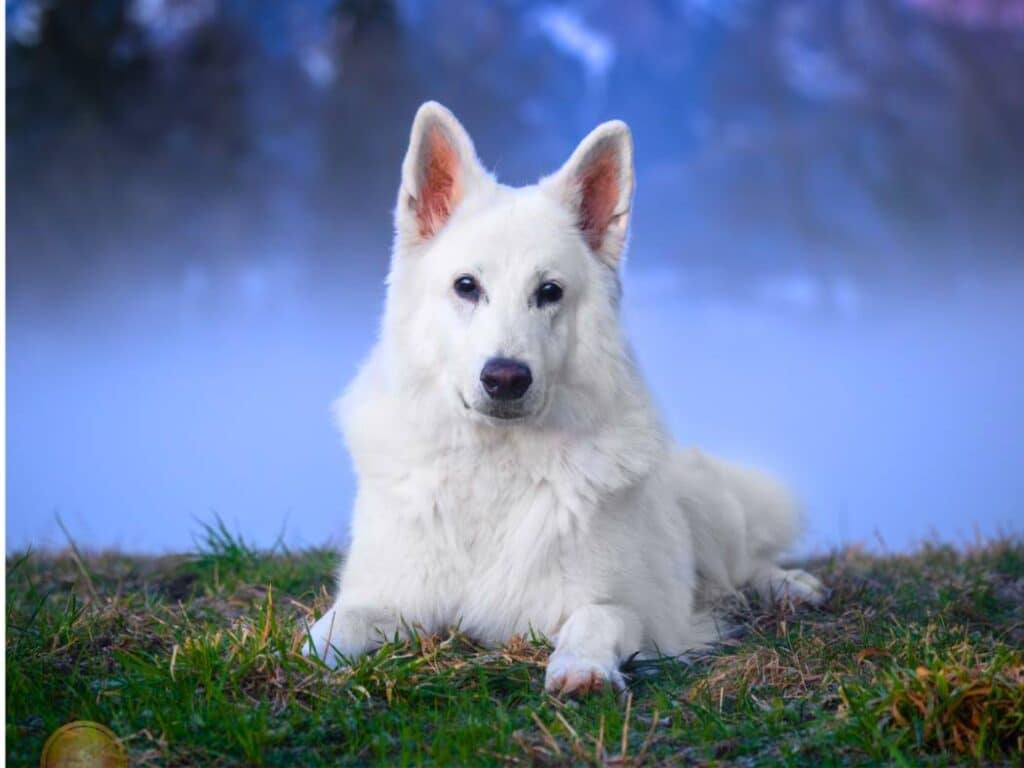According to the White German Shepherd Dog Club International, “Other than color, the white German Shepherd is identical to the standard colored German Shepherd. Color does not affect the dog’s physical structure, personality, temperament, or trainability.”
Although the AKC considers the white color in German Shepherds a fault and the UKC recognizes them as a separate breed named ‘White Shepherds,’ these dogs can still make excellent family companions with proper socialization and training.
Read on below to find out more about White GSDs and whether they could be the dog you are looking for.
White German Shepherd: Overview
| Characteristic | White German Shepherd |
|---|---|
| Weight | Male: 65-90 pounds (30-41 kg); Female: 50-70 pounds (23-32 kg) |
| Height | Male: 24-26 inches (60-65 cm); Female: 22-24 inches (55-60 cm) |
| Life Expectancy | 9-13 years |
| Group | Herding |
| Cost | $800-$2000 |
| Coat Type | Double coat with a dense outer coat and a softer undercoat |
| Coat Color | White |
| Temperament | Intelligent, loyal, confident, courageous, and versatile |
| Trainability | Highly trainable |
| Exercise Needs | High; requires 1-2 hours of regular physical and mental stimulation |
| Grooming | Moderate; regular brushing to manage shedding and maintain coat health |
| Health Issues | Prone to hip dysplasia, elbow dysplasia, and certain genetic conditions |
| Common Uses | Search and rescue, service dogs, family pets |
| Energy Level | High |
| Socialization | Requires early and ongoing socialization for balanced behavior |
| Barking tendency | Moderate |
| Protective Instinct | Strong |
| Feeding | 3-4 cups of high-quality dry food per day for adult dogs |
| Living Conditions | Adaptable, but thrive in homes with space and regular exercise |

Are White German Shepherds Recognized by AKC?
White German shepherds are recognized and can be registered with the American Kennel Club as long as both parents are registered. However, the white color is considered a fault according to the AKC German Shepherd breed standard.
This means that a white German Shepherd can not participate in the AKC conformation competitions, but the white GSDs can still participate in AKC performance events, such as obedience trials, tracking trials, temperament tests, and herding events.
You may also choose to register your white German Shepherd with the United Kennel Club or the UKC under their separate breed name – ‘White Shepherd’, and may show your dog in the UKC’s conformation ring as a German Shepherd Dog.
How Do German Shepherds Acquire a White Coat Color?
The white coat color in German Shepherds is primarily the result of a recessive gene. It means that a dog must inherit two copies of this gene (one from each parent) to express the white coat color.
If a dog inherits only one copy of the gene, it will have a standard coat color but may carry the gene.
Both parents must carry at least one copy of the white coat gene for the offspring to potentially have a white coat. If both parents carry the gene and pass it on to their offspring, the puppy may have a white coat.

Are White German Shepherds Healthy?
The white gene only masks a German Shepherd’s coat color, it does not cause any specific health problems or damage the genetic makeup of a GSD unless there were genetic health problems already present in the dog’s parents.
A word of caution:
Because white German Shepherds are considered a fault and you can’t show them, there’s no way to get them professionally evaluated by a judge.
As a result, there is no one, no organization making sure that the white German Shepherds conform to the German Shepherd breed standards.
The lack of such evaluations and testing for white German Shepherds results in deviations from the breed standard, potentially leading to behavioral and health issues.
So the breeding of white German Shepherds is often left to individuals who are primarily drawn to their color or those who may not prioritize adherence to breed standards.
This includes backyard breeders who may not be selective in their pairings, further contributing to potential issues in the breed.
So, if you’re planning to get a white German Shepherd, make sure that you choose a reputable breeder who prioritizes the overall health and well-being of the dogs.
This includes proper health testing, ethical breeding practices, and a commitment to breeding for the betterment of the breed rather than solely focusing on coat color.
RELATED: Can a German Shepherd Have Blue Eyes?

White German Shepherd Appearance
Size & Weight
White German Shepherds are generally the same size as other variations of the breed.
Males typically stand between 24 to 26 inches tall at the shoulder, while females range from 22 to 24 inches tall.
Males weigh around 65 to 90 pounds, whereas females weigh between 50 to 70 pounds on average.
These numbers may vary slightly depending on genetics and individual differences.
White GSDs are not albino shepherds.
Although some people mistake them as albino dogs, white German Shepherds are not true albinos.
Albinism is characterized by a complete absence of pigmentation in the skin, hair, and eyes.
In contrast, white German Shepherds have pale or cream-colored coat but still possess pigmented skin and eyes. This distinction sets them apart from true albino animals.
RELATED: German Shepherd Eye Colors

White German Shepherd Temperament
The white German Shepherd’s temperament does not differ from that of their standard color counterparts.
White GSDs are as courageous, obedient, intelligent, and trainable as other German Shepherd colors which makes them suitable for various tasks such as search and rescue operations, therapy work, or even just being an obedient family pet.
Once they form a bond with their human pack members, they become fiercely protective and devoted companions.
These dogs have an innate sense of guardianship that makes them excellent watchdogs.
They will go above and beyond to keep their loved ones safe from any potential threats.
White GSDs like other GSDs can be reserved with strangers but are generally not aggressive.

White German Shepherd Training & Socialization
Just like their standard colored counterparts, white GSDs need to be trained and properly socialized from an early age.
It’s important to introduce them to a variety of people, including children, as well as other animals so they grow up to be well-adjusted adult dogs.
White German Shepherds are active dogs that require both mental stimulation and physical exercise to thrive.
Without adequate outlets for their energy, they may become bored or exhibit destructive behaviors.
An adult white German Shepherd needs at least 1-2 hours of walks, runs, or playtime to keep them physically fit and mentally satisfied.
RELATED: How Much Exercise Does a German Shepherd Need? (Chart Included)

Health Problems
White German Shepherds, like their traditional-colored counterparts, are generally healthy dogs, but they can be prone to certain health concerns.
- Skin Issues: White-coated German Shepherds may be more susceptible to skin problems such as allergies and sunburn due to their lighter pigmentation. Regular grooming and protection from excessive sun exposure can help prevent these issues.
- Deafness: Some White German Shepherds are more prone to congenital deafness, particularly if they have a completely white coat.
- Hip Dysplasia: Hip dysplasia is a genetic condition where the hip joint doesn’t develop properly, leading to arthritis and lameness.
- Elbow Dysplasia: Similar to hip dysplasia, elbow dysplasia is a hereditary condition that affects the development of the elbow joint. It can lead to pain and lameness, and like hip dysplasia.
- Eye Problems: White-coated dogs, including White German Shepherds, can be more prone to certain eye issues, such as cataracts and progressive retinal atrophy (PRA).
- Autoimmune Disorders: Some White German Shepherds may be predisposed to autoimmune disorders, where the immune system mistakenly attacks the body’s own cells.
- Thyroid Issues: Thyroid problems, such as hypothyroidism, can affect White German Shepherds. Regular veterinary check-ups, including thyroid function tests, can help identify and manage any thyroid-related concerns.
It’s important to note that responsible breeding practices play a significant role in minimizing the prevalence of genetic health issues in any dog breed, including White German Shepherds.
RELATED: German Shepherd Common Health Problems

Check out this beautiful video of a white German Shepherd…
Frequently Asked Questions
How much do white German Shepherds cost?
The price of these adorable pups can vary depending on several factors, including lineage, breeder reputation, and location. On average, you can expect to pay between $800 and $2000 for a white German Shepherd puppy.
Reputable breeders who prioritize health testing and responsible breeding practices often charge more for their puppies compared to backyard breeders or puppy mills.
While it may be tempting to opt for a cheaper option, purchasing from a reputable breeder ensures that you are getting a healthy and well-cared-for puppy.
Are White German Shepherds Rare?
White German Shepherds can be considered rare only because most GSD breeders avoid breeding white-coated German Shepherd dogs since they can not be shown in the conformation events.
Their prevalence can vary depending on the region and breeding practices. In some areas, you may find a higher concentration of white German Shepherds, while in others, they might be less common.

Are White German Shepherds Deaf?
Not all white German Shepherds are deaf. However, congenital deafness has been found in 85 dog breeds, including white German Shepherds. The piebald gene is responsible for white skin and white fur in dogs, and dogs that carry the piebald gene are often affected by deafness.
Piebaldism results from the absence of melanocytes, the cells that create the pigment melanin. These melanocytes are the part of a dog’s DNA that determines coloration, such as brown or black hair, or blue or brown eyes. When a dog is born without melanocytes, a predominantly white coat is the result.
Are White German Shepherds Aggressive?
The white coat color in German Shepherds does not affect their temperament or make them more or less aggressive. Aggression in any dog is often a result of factors such as fear, lack of socialization, inadequate training, or a negative past experience.
White German Shepherds, like their counterparts with different coat colors, can be loyal, intelligent, and trainable. Their behavior is shaped by their upbringing, environment, and the way they are treated by their owners.

Can White German Shepherds Be Police Dogs?
Since white German Shepherds do not conform to the breed standards, they are typically not used as police dogs, guard dogs, or to participate in protection dog sports such as Schutzhund.
That said, white German Shepherds can potentially be trained and employed as police dogs. The color of the coat does not inherently affect a dog’s ability to perform specific tasks or duties.
What matters most for police dogs, including German Shepherds, is their temperament, intelligence, trainability, and physical fitness.
Do White German Shepherds Make Good Pets?
Yes, white German Shepherds can make excellent pets for the right owners. Like German Shepherds of other colors, white German Shepherds are known for their intelligence, loyalty, and versatility. They can be wonderful family companions, provided they receive proper training, socialization, and attention.

How Long do White German Shepherds Live?
The lifespan of a white German Shepherd, like any other German Shepherd, typically ranges between 9 to 13 years, with some living even longer. The lifespan of a dog can be influenced by various factors, including genetics, overall health, diet, exercise, and veterinary care.
Responsible breeding practices, regular veterinary check-ups, a balanced diet, proper exercise, and a loving home environment all contribute to the overall well-being and longevity of a white German Shepherd.
RELATED: German Shepherd Lifespan
How Many German Shepherd Colors Are There?
Here is a list of the German Shepherd coat colors recognized by AKC:
- Black
- Black & Cream
- Black & Red
- Black & Silver
- Black & Tan
- Gray
- Sable
- White
- Liver
- Blue
- Bi-Color
Here is a list of the rare German Shepherd coat colors that are not recognized by AKC:

Final Remarks
In conclusion, white German Shepherds, like their counterparts of other colors, can make wonderful and loyal companions when bred responsibly and cared for appropriately. While coat color itself is not a direct indicator of health or temperament, potential genetic concerns associated with the white coat gene should be considered. Responsible breeders prioritize health screenings, genetic testing, and ethical breeding practices to minimize the risk of hereditary conditions.




